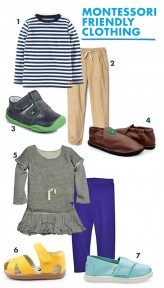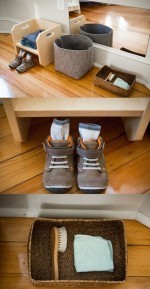Independent Dressing At Home
Independence is the key to success in Montessori education, as Dr. Montessori herself once wrote:
“Never help a child with a task at which he feels he can succeed.”
However, many parents find it challenging to implement this concept at home. So, what exactly makes a young child feel accomplished? Look no further than the empowering realm of dressing and undressing.
Revamp Your Child’s Wardrobe: Brands for the Independent Dresser
When parents ask me how to foster independence in their children, I often suggest starting with dressing themselves. Allowing and encouraging kids to dress independently not only enhances their self-perception but also strengthens their gross and fine motor control. Moreover, it evencontributes to spatial reasoning. And let’s not forget the added bonus: smoother, stress-free mornings! As the new school year looms around the corner, let’s explore a few tips to kickstart your child’s independence:

- Boden
- Gap
- Pediped
- Softstar Shoes
- Burt’s Bees Baby
- See Kai Run
- TOMS
5 Tips for Independent Dressing at Home
- Simplify choices. With the multitude of children’s clothing styles available, not all may be suitable for the current season or occasion. Offer your child a limited selection of appropriate tops, bottoms, and shoes to choose from. Concerned about clashing colors and patterns? Stick to neutrals or mix-and-match styles.
- Minimize frustration. When your child is just beginning to dress independently, prov
ide clothes that are easy to put on. Loose tee shirts and elastic waist pants are fantastic options. Save buttons, zippers, and snaps for when your child is ready to take on a challenge. It’s also an ideal time to introduce Montessori dressing frames, adding a touch of fun to the learning process! - Break down the task. Consider all the steps involved when you put on a pair of pants. Apply the same mindset when guiding your child through the process. Initially, they may need assistance with balance, scrunching up a pant leg, or starting a zipper. Patience is key!
- Avoid correcting. Suppose your child spends 15 minutes struggling to put on a shirt, only to discover it’s on backward. Let it go. Instead of pointing out mistakes, prioritize their sense of pride and accomplishment. In fact, your child might even realize the error and correct it independently. However, if safety is a concern, such as shoes on the wrong feet that could cause tripping, gently draw attention to it.
- Allow plenty of time. Learning a new skill requires practice, and children need plenty of it before becoming efficient. If you’re running behind schedule one morning, expecting your child to dress quickly may be unrealistic. Consider this when planning your Montessori at home routine.
 Preparing the Environment
Preparing the Environment
Here is an example of a dressing area for a young preschooler. Everything is laid out and ready for the child, much like any prepared environment. The chair offers a steady place to sit down and put on pants, a shirt, socks, and shoes. The mirror, brush, and cloth add another level of self-care awareness. The grey basket provides a place for dirty laundry.
Teaching a child to be self-sufficient can be a daunting task! There certainly is more upfront preparation, but it is absolutely worth the outcome of a confident, competent, independent child!
Add these tips to the Helping Hands Toolbox and you’ll have one independent kid on your hands!





I was wondering if you have any tips on this for getting kids invested in getting dressed. Basically, my daughter can dress and undress herself and is happy to do it when she’s interested in it, but it’s not something she feels a lot of pride about–I mean, she’s proud enough of herself for being able to, but once she’s able to do something, it’s no longer a source or real pride or motivation for her because she’s on to the next thing, so we can’t get her on board that way. She doesn’t care about clothes, so I try to have her pick from 2 or 3 options at the store when we’re buying clothes and when we’re picking out her clothes in the morning, but it’s all I can do to get her to give me an answer most of the time, so I don’t like to push it. Choosing her clothes is also not a motivator, and I don’t want the choice to become a burden. Like a lot of kids her age, she doesn’t often want to put on clothes, so sometimes it can be a real struggle–even when we make sure she gets plenty of sleep and has plenty of time to get ready. She’ll hem and haw and fuss so much that then we do get short on time, but I would be wrestling the clothes on her no matter how much time she did or didn’t have. Clothes seem to be an outlet for absolutely every frustration, from the fact that, say, she wants today to be swim class day rather than a school day, to grief over the fact that she didn’t sleep with her favorite pair of shoes the night before, or the fact that our dog died last year. I don’t want to fight with her like this every morning, and in just about every other situation, we’ve managed to develop techniques that avoid power struggles and are positive and effective, but this one really has me stumped. Thanks for any insight you can give.
– Emily
I like that you said that when helping your kid pick out their outfit you should offer a few appropriate options for tops, bottoms, and shoes for your child to choose from. I am trying to help my daughter feel more independent so I am trying to help her choose her own outfits in the morning. I think that giving her different clothes options would help her still have a choice without it ending up with her wearing shoes that don’t match at all or something like that.